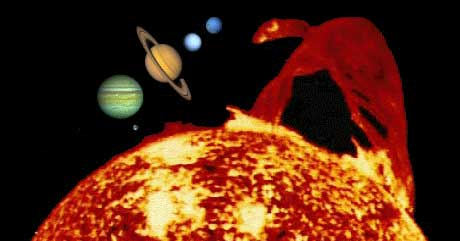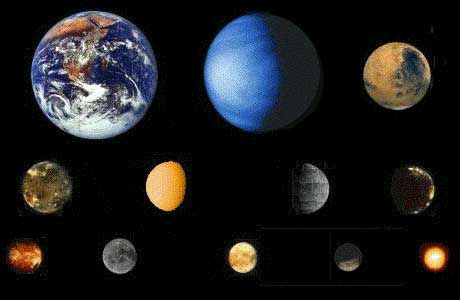Here are listed the largest, brightest and densest of the major bodies in the solar system and those with best prospects for life.
The Largest
There are 17 bodies in the solar system whose radius is greater than 1000 km.

The composite above shows the Sun and the 5 largest planets at a scale of 3200 km/pixel. (Earth is the tiny spot between Jupiter and the Sun).

This composite shows Earth and the remaining 11 large solar system objects at a scale of 100 km/pixel.
| Distance | Radius | Mass | |||
|---|---|---|---|---|---|
| Name | Orbits | (000 km) | (km) | (kg) | |
| --------- | ------- | -------- | ------- | ------- | |
| Sun | 697000 | 1.99e30 | |||
| Jupiter | Sun | 778000 | 71492 | 1.90e27 | |
| Saturn | Sun | 1429000 | 60268 | 5.69e26 | |
| Uranus | Sun | 2870990 | 25559 | 8.69e25 | * |
| Neptune | Sun | 4504300 | 24764 | 1.02e26 | * |
| Earth | Sun | 149600 | 6378 | 5.98e24 | |
| Venus | Sun | 108200 | 6052 | 4.87e24 | |
| Mars | Sun | 227940 | 3398 | 6.42e23 | |
| Ganymede | Jupiter | 1070 | 2631 | 1.48e23 | + |
| Titan | Saturn | 1222 | 2575 | 1.35e23 | + |
| Mercury | Sun | 57910 | 2439 | 3.30e23 | + |
| Callisto | Jupiter | 1883 | 2400 | 1.08e23 | |
| Io | Jupiter | 422 | 1815 | 8.93e22 | |
| Moon | Earth | 384 | 1738 | 7.35e22 | |
| Europa | Jupiter | 671 | 1569 | 4.80e22 | |
| Triton | Neptune | 355 | 1353 | 2.14e22 | |
| Pluto | Sun | 5913520 | 1160 | 1.32e22 |
*Note: Neptune is slightly denser than Uranus.
+Note: Mercury is much denser than Ganymede and Titan.
The Brightest
There are 12 major bodies brighter than magnitude 6 (as viewed from Earth). All of these can be seen with the unaided eye or with binoculars.
| Distance | Radius | |||
|---|---|---|---|---|
| Name | Orbits | (000 km) | (km) | Vo * |
| --------- | ------- | -------- | ------- | --- |
| Sun | ? | 0 | 697000 | -26.8 |
| Moon | Earth | 384 | 1738 | -12.7 |
| Venus | Sun | 108200 | 6052 | -4.4 |
| Jupiter | Sun | 778000 | 71492 | -2.7 |
| Mars | Sun | 227940 | 3398 | -2 |
| Mercury | Sun | 57910 | 2439 | -1.9 |
| Saturn | Sun | 1429000 | 60268 | 0.7 |
| Ganymede | Jupiter | 1070 | 2631 | 4.6 |
| Io | Jupiter | 422 | 1815 | 5 |
| Europa | Jupiter | 671 | 1569 | 5.3 |
| Uranus | Sun | 2870990 | 25559 | 5.5 |
| Callisto | Jupiter | 1883 | 2400 | 5.6 |
*Note: Vo = Object’s magnitude in visible light at opposition.
Note: Comets are often quite bright during their brief passage near the Sun.
Warning: Do NOT look directly at the Sun. Looking directly at the Sun can cause severe eye damage; doing so with binoculars or a telescope without specialized solar filters will cause instantaneous and permanent blindness.
The Densest
There are 11 major bodies whose density is greater than 3 g/cm3:
| Radius | Mass | ||
|---|---|---|---|
| Name | (km) | (kg) | Dens * |
| --------- | ------- | ------- | ---- |
| Earth | 6378 | 5.97E+24 | 5.52 |
| Mercury | 2439 | 3.30E+23 | 5.42 |
| Venus | 6052 | 4.87E+24 | 5.26 |
| Adrastea | 10 | 1.91E+16 | 4.5 |
| Mars | 3398 | 6.42E+23 | 3.94 |
| Io | 1815 | 8.93E+22 | 3.53 |
| Moon | 1738 | 7.35E+22 | 3.34 |
| Elara | 38 | 7.77E+17 | 3.3 |
| Sinope | 18 | 7.77E+16 | 3.1 |
| Lysithea | 18 | 7.77E+16 | 3.1 |
| Europa | 1569 | 4.80E+22 | 3.01 |
*Note: Density is in grams per cubic centimeter.
Note: Data for the smaller satellites are not very accurate.
There are also many dense asteroids, especially the M-types.
The Best Prospects for Life
| Name | Why |
|---|---|
| --------- | ------- |
| Earth | 🙂 |
| Mars | most Earth-like; more so in the past |
| Europa | may have liquid water |
| Titan | complex chemistry and liquids likely |
| Enceladus | may have liquid water |
| Io | complex chemistry, warmer than most |
| Jupiter | long shot: warm, plenty of organic material |
Recent evidence of water on Mars notwithstanding, all of this remains very speculative. None of these prospects are really very good. Good arguments can be made why life (at least life as we know it) cannot exist on any of these bodies. (More about life on Europa.) But even if no life exists on other bodies in our solar system, it seem to be likely that there’s probably life elsewhere in our galaxy. There are good arguments on both sides of that issue, however, the only things most scientists agree upon are that we just don’t know and that more evidence is needed.
